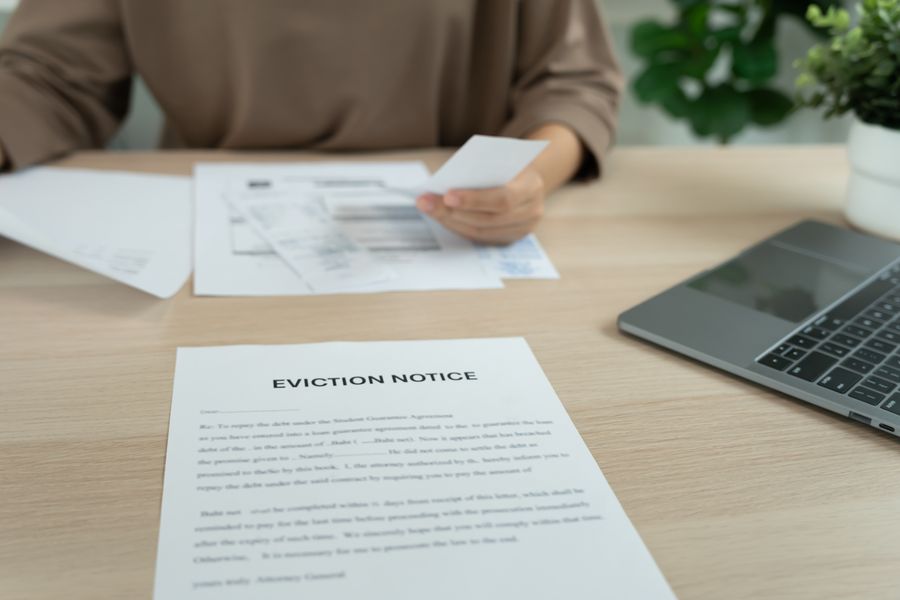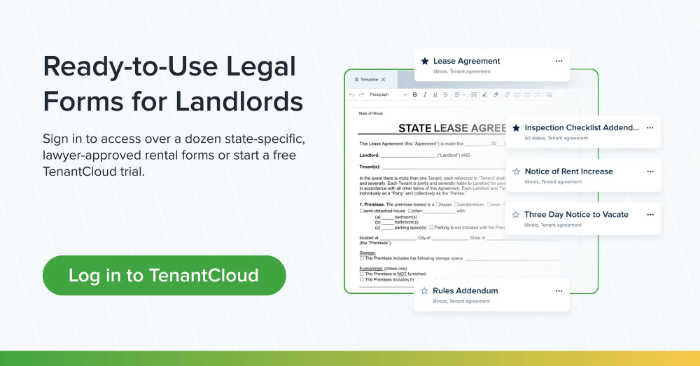No one purchases a rental property dreaming of an eviction. Yet even the most careful landlord occasionally meets a tenancy that goes sideways: missed rent, broken lease terms, or worse.
When that happens, knowing what is eviction (and what it isn’t) keeps frustration and legal risk to a minimum. Think of eviction as a structured safety valve: you’re not “kicking someone out,” you’re activating a court-approved procedure that protects your investment while giving the tenant a fair chance to make things right.
In the next few minutes, we’ll walk through the big picture: why evictions happen, how the eviction process flows from notice to quit to courtroom, and what to expect if your case reaches a judge. If you’d like a refresher on healthy day-to-day communication, first check out our quick guide on building a strong landlord-tenant relationship. Otherwise, let’s dive in!
What Is Eviction and Why Does It Happen?
An eviction is the legal process—sometimes referred to as a summary process—that allows a landlord to remove a tenant from a rental unit. Because it flows through the courts, it’s never personal; it’s a contractual remedy when the lease is no longer being honored. Here’s what typically triggers this process:
- Nonpayment of rent. The tenant stops or chronically delays paying rent.
- Lease violations. Extra roommates, a pet that isn’t allowed, or ignoring quiet hours all qualify.
- Illegal activity. Drug sales or other criminal behavior on the premises.
- Property damage. Serious or willful destruction beyond normal wear and tear.
Even if you feel that a tenant should be removed, it’s best to get a court order first. Changing locks or piling belongings on the curb without one can expose you to sizable fines (and, ironically, delay removal). Always let the court supervise the exit so both sides get due process, and you avoid a retaliatory eviction claim down the road.
The Eviction Process from Start to Finish
Below is the bird’s-eye view of the eviction process. Your state may shuffle a step or two, but the backbone rarely changes:
- Serve a written eviction notice—most commonly a notice to quit. This spells out the problem, cites the lease clause, and gives the tenant X days to cure or leave.
- Wait the statutory period. If the tenant pays rent or rectifies the violation, the issue is resolved. If not, it’s time for step three.
- File the eviction case (also called an unlawful detainer or summary process complaint) in small claims court, housing court, or district court, depending on local rules and the amount of back rent.
- Attend the court date. Bring the lease, payment ledger, photos, emails—anything that shows the judge you followed the rules.
- Landlord wins? The court issues a writ of possession (sometimes called an execution).
- Sheriff or constable enforces the order, removes the tenant, and secures the unit.
Most cases revolve around back rent, but you can also ask the judge for storage costs, future rent due under the lease, and repairs tied to tenant damage.
Notice to Quit: Types of Eviction Notices Landlords Can Use
Choosing—and timing—the right written notice is crucial. Courts often dismiss cases because the landlord submitted the wrong form or mailed it late. Here are a few types of eviction notices you might send, when to use them, and your tenant’s options.
Notice Type | When to Use | Tenant’s Options |
Pay Rent or Quit | Nonpayment right after the grace period | Pay full balance or vacate |
Cure or Quit | Any lease violation—unauthorized pets, noise, etc. | Fix the issue or vacate |
Unconditional Quit | Severe or repeated issues—drug sales, major destruction | No cure period; must vacate |
As a landlord, you must follow these guidelines regarding timing:
- 30-day notice: Typical for month-to-month agreements.
- 60-day notice: Common for leases of a year or longer.
Deliver each notice to quit by certified mail (or whichever method your statute names). A tiny mailing error can restart the clock—and nobody wants to redo paperwork while the rent meter keeps running.
What to Expect During an Eviction Court Case
Once the paperwork is filed, an eviction court case resembles any other civil lawsuit: brief yet formal. Many jurisdictions route evictions into specialized housing courts, while others use district or small claims courts.
You’ll also need evidence: Leases, ledgers, time-stamped notices, maintenance logs, even text screenshots. The cleaner your file, the quicker the judge decides. Then comes the hearing. Each side testifies. The judge may encourage mediation services, but if that fails, a decision follows.
Missing a court date is disastrous for tenants: the judge often enters a default judgment, granting you possession and any proven monetary claims. Still, victory isn’t instant keys-in-hand. The clerk must process the writ, then the sheriff schedules the physical move-out. Tenants can sometimes appeal, which allows for a brief pause in enforcement.
Even after winning, only law enforcement can legally change the locks or remove personal belongings. Stick to the script, and the process—though never fun—stays predictable and legally airtight.
Legal Help and Mediation Services for Landlords
Eviction is a legal process, and that means your best ally—especially early on—is solid legal guidance. Whether you're managing one unit or multiple properties, consulting a local landlord-tenant lawyer before filing can save time, money, and stress. It ensures that your paperwork is in order, your notice to quit meets state requirements, and your documentation supports your case in court.
Waiting until your eviction court case hits a snag is usually more expensive than asking a few smart questions up front.
That said, not every lease conflict requires a court hearing. In fact, many issues can be resolved through mediation services, especially when the problem stems from temporary hardship rather than ongoing noncompliance. If a tenant falls behind due to job loss, illness, or family emergencies, you might consider:
- Offering a payment plan
- Temporarily reducing future rent
- Extending a grace period before escalating
Keep in mind that if the tenant lives in subsidized housing, they may have additional legal protections that require extra steps or restrict certain kinds of lease termination altogether. In those situations, it’s especially important to follow your state’s guidelines to the letter.
From automated rent logs to digital lease tracking, use tools that make it easier to demonstrate a pattern of compliance and communication, something judges look for when evaluating eviction claims.
Finally, don’t forget to start with good screening practices. A portable tenant screening report can give you insights into a tenant’s rental history, payment patterns, and past evictions before the lease is even signed. Prevention really does begin at the application stage.
The Summary Process: A Closer Look at the Legal Framework
In many states, eviction court cases fall under a system called the summary process. It’s essentially the fast-track legal route for landlords to regain control of a rental property when a lease has been violated.
But “fast” doesn’t mean informal. The summary process typically involves three core steps:
- Filing a complaint. You submit formal paperwork to the court that outlines your case: what lease terms were broken, what notices were sent, and what resolution you're requesting.
- Scheduling a trial. The court sets a court date—often within a few weeks—where both you and the tenant can present evidence.
- Receiving a judgment. If the judge decides in your favor, you'll be issued a writ of possession, allowing a sheriff or constable to enforce the ruling and remove the tenant.
This structure is in place to protect both parties. The legal process provides tenants with the opportunity to defend themselves, and it affords you, the landlord, a clear legal path to move forward if lease violations are serious or persistent.
Want to make sure your documentation is airtight? Features like a lease builder, digital payment tracking, and customizable notice templates can help. Some tools allow you to even track property inspections, ensuring a record of the unit's condition before, during, and after tenancy.
Tips to Prevent Eviction Situations Before They Start
The best way to manage an eviction? Avoid it altogether. While some issues are beyond your control, a proactive, tech-enabled management style can reduce the likelihood of ever reaching the courthouse. Here are a few tried-and-true strategies:
- Use a portable tenant screening report. A strong rental history, reliable income, and clean credit can flag whether a tenant is likely to make consistent rental payments.
- Automate rent collection. With TenantCloud, tenants can set up auto-pay or receive rent reminders that nudge them to pay on time—no awkward texts required.
- Schedule regular property inspections. Routine check-ins catch wear and tear before it becomes serious property damage or a lease violation.
- Foster strong communication. A courteous, respectful relationship makes it more likely that tenants will come to you early when problems arise.
Not every problem can be prevented, but many can be managed more smoothly with the right systems in place.
Rental Assistance and Tenant Protections to Be Aware Of
If your tenant is facing eviction, they may be eligible for some form of rental assistance, especially if the hardship is recent or linked to medical bills, unemployment, or pandemic-related challenges. Here are a few resources to keep on your radar:
- Local housing agencies may offer short-term grants or emergency funds.
- State-funded hardship programs can sometimes help tenants catch up on back rent.
- COVID-era aid remains in place in some municipalities, even as national programs wind down.
Why does this matter to you as a landlord? Because courts often view eviction as a last resort. If your tenant can demonstrate they’re actively pursuing help—and you’re unwilling to cooperate—it may affect the court judgment or cause delays.
Additionally, tenants have legal defenses that can derail your eviction case altogether:
- Retaliatory eviction: Making an attempt to evict a tenant for reporting code violations or requesting repairs.
- Housing discrimination: Eviction based on race, religion, national origin, family status, disability, etc.
- Uninhabitable conditions: If you’ve neglected repairs or allowed health hazards to persist.
That’s why it’s crucial to document everything, from late rent notices and repair requests to lease violations and communication logs, as well as tenant rent payment habits. Being organized is not just professional, but also protective.
Stay Compliant, Stay Efficient
Eviction is a last-resort solution to a difficult situation, but when it becomes necessary, it must be handled carefully and in accordance with the law. Along the way, having the right tools can make all the difference. With TenantCloud, you get more than a place to list and lease. You get:
- State-specific lease templates with e-signature support
- Easy-to-track rent collection and payment history
- Built-in screening reports and maintenance tracking
- A centralized hub for storing all your tenant interactions, securely and accessibly
Ready to get started? Sign up for a free 14-day trial and see how TenantCloud simplifies property management—from rent collection to legal compliance.








